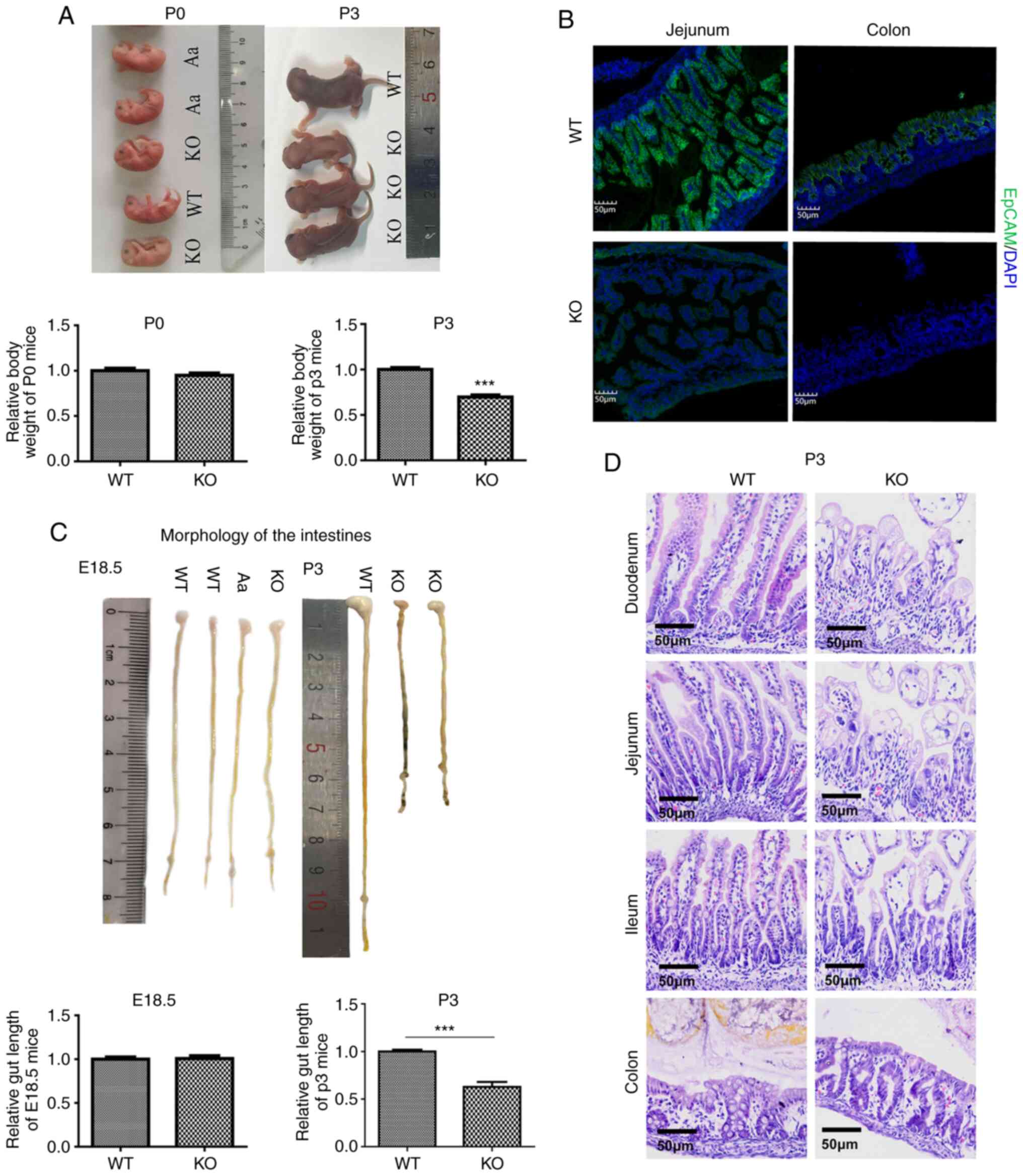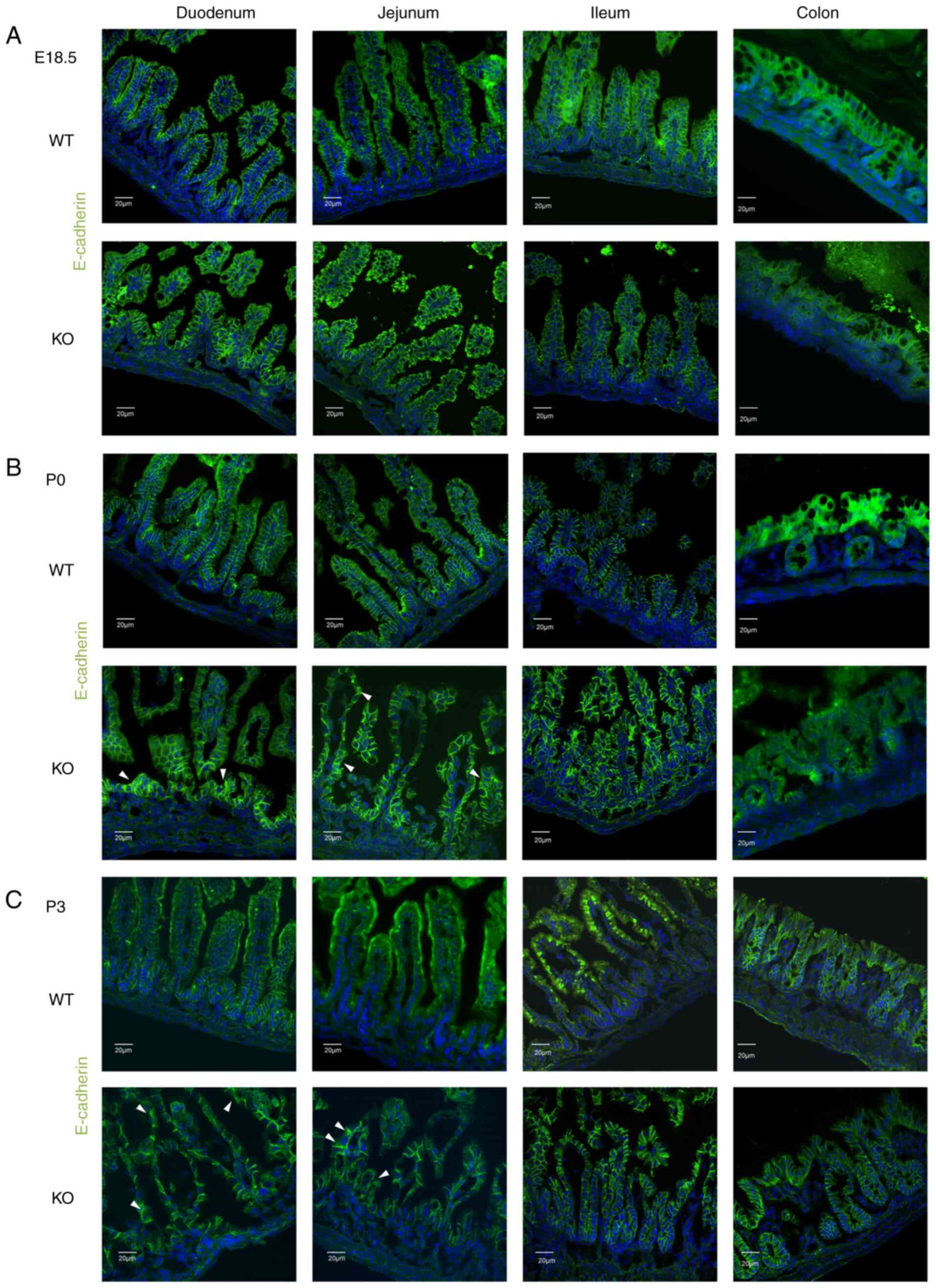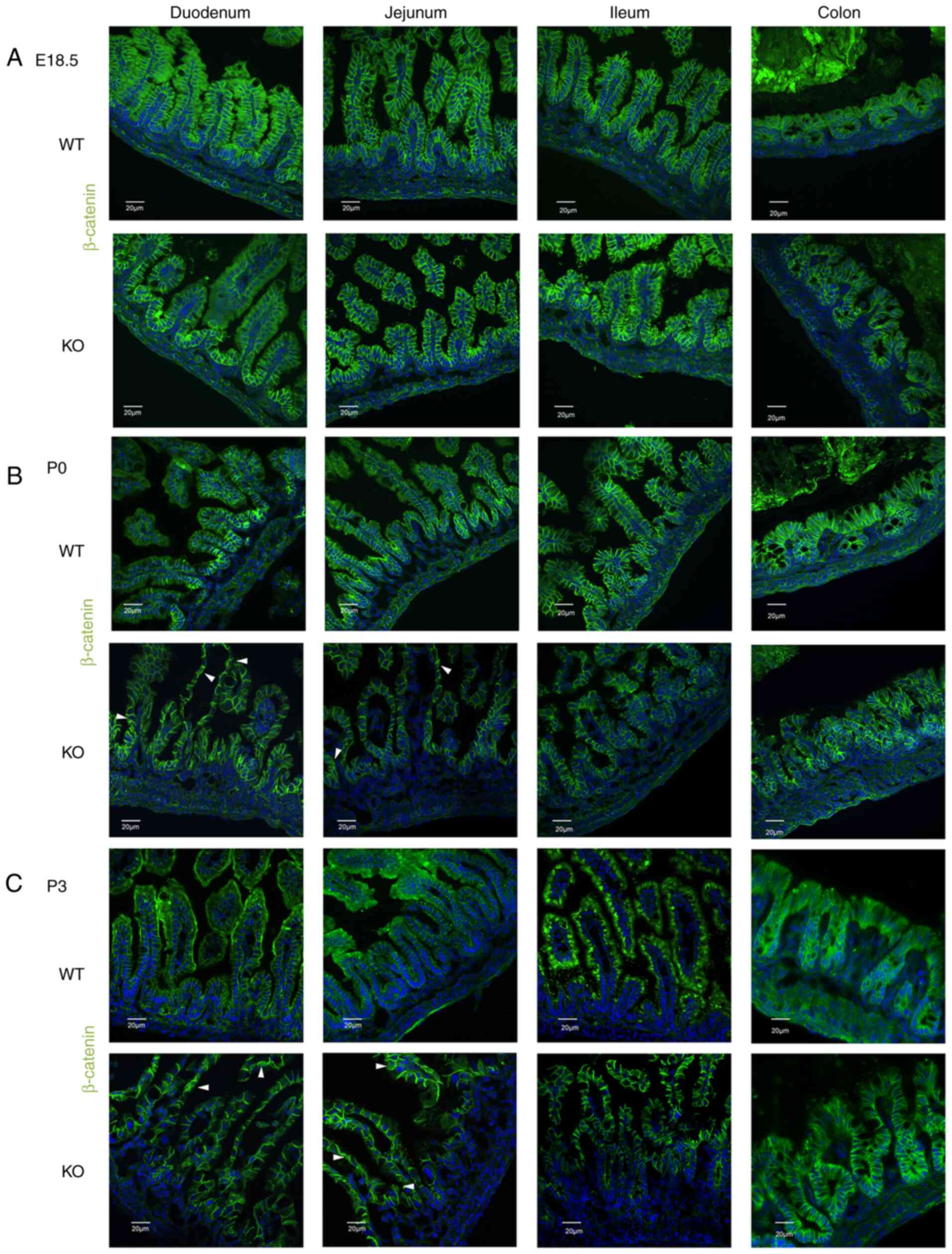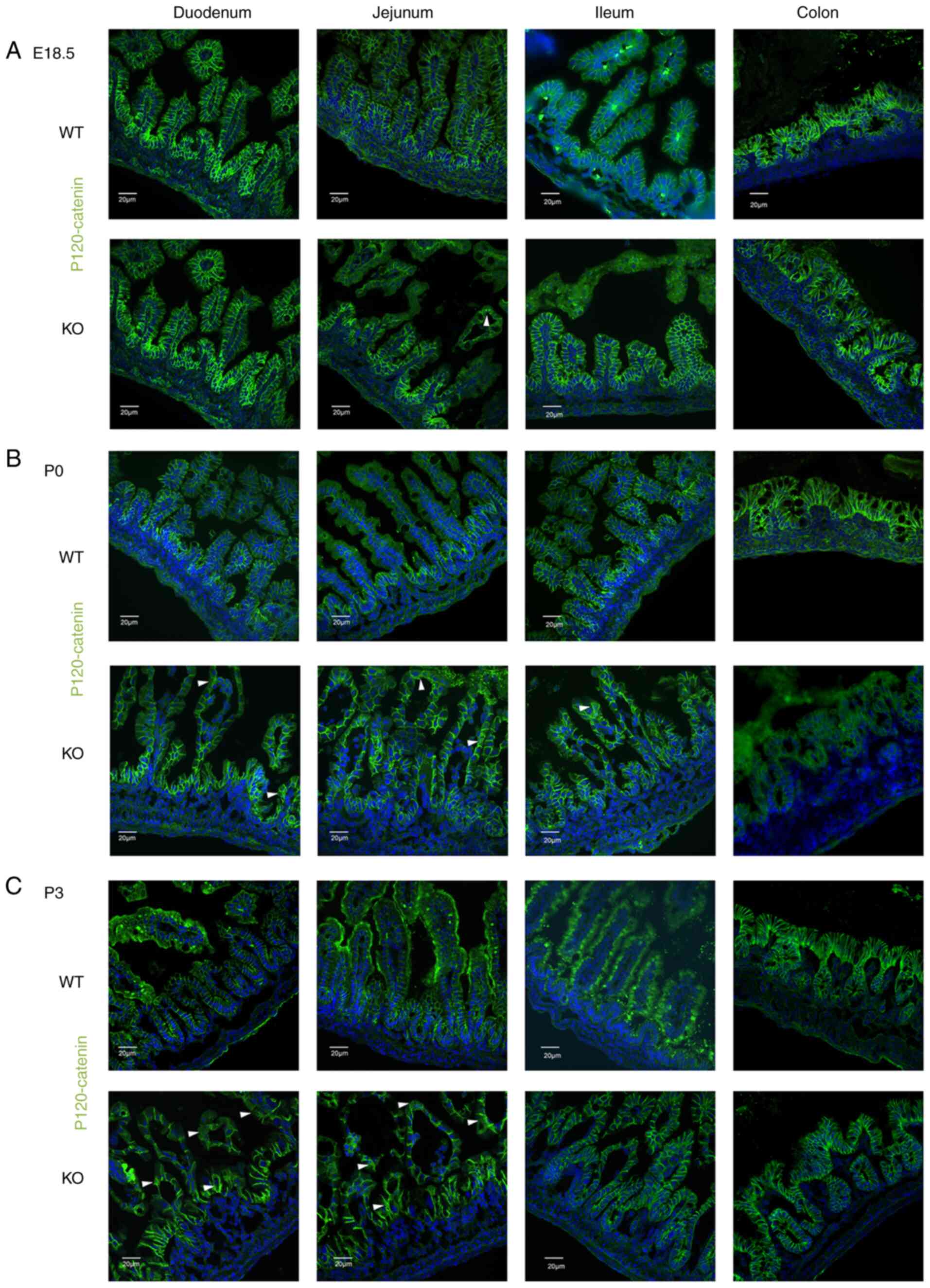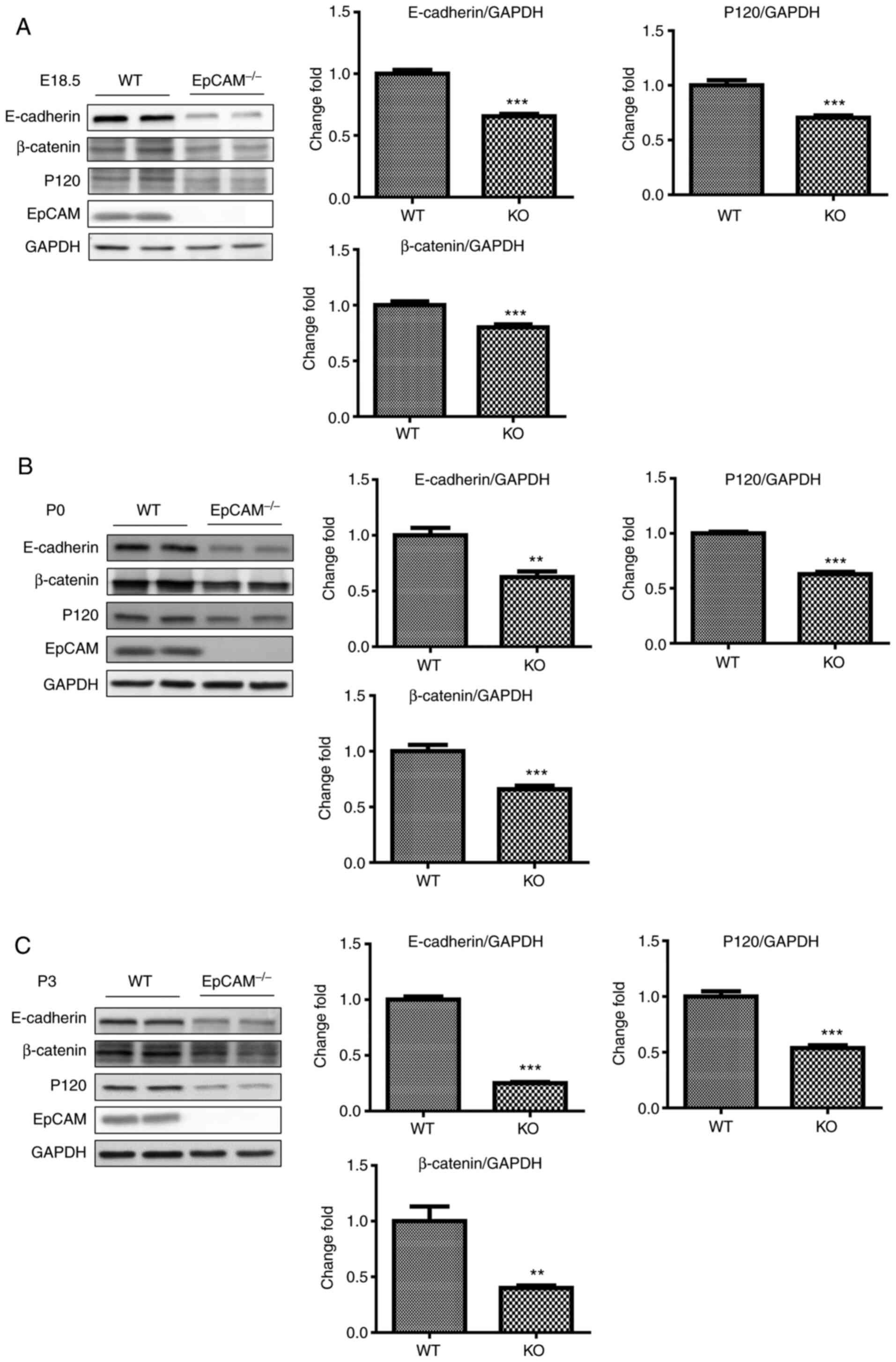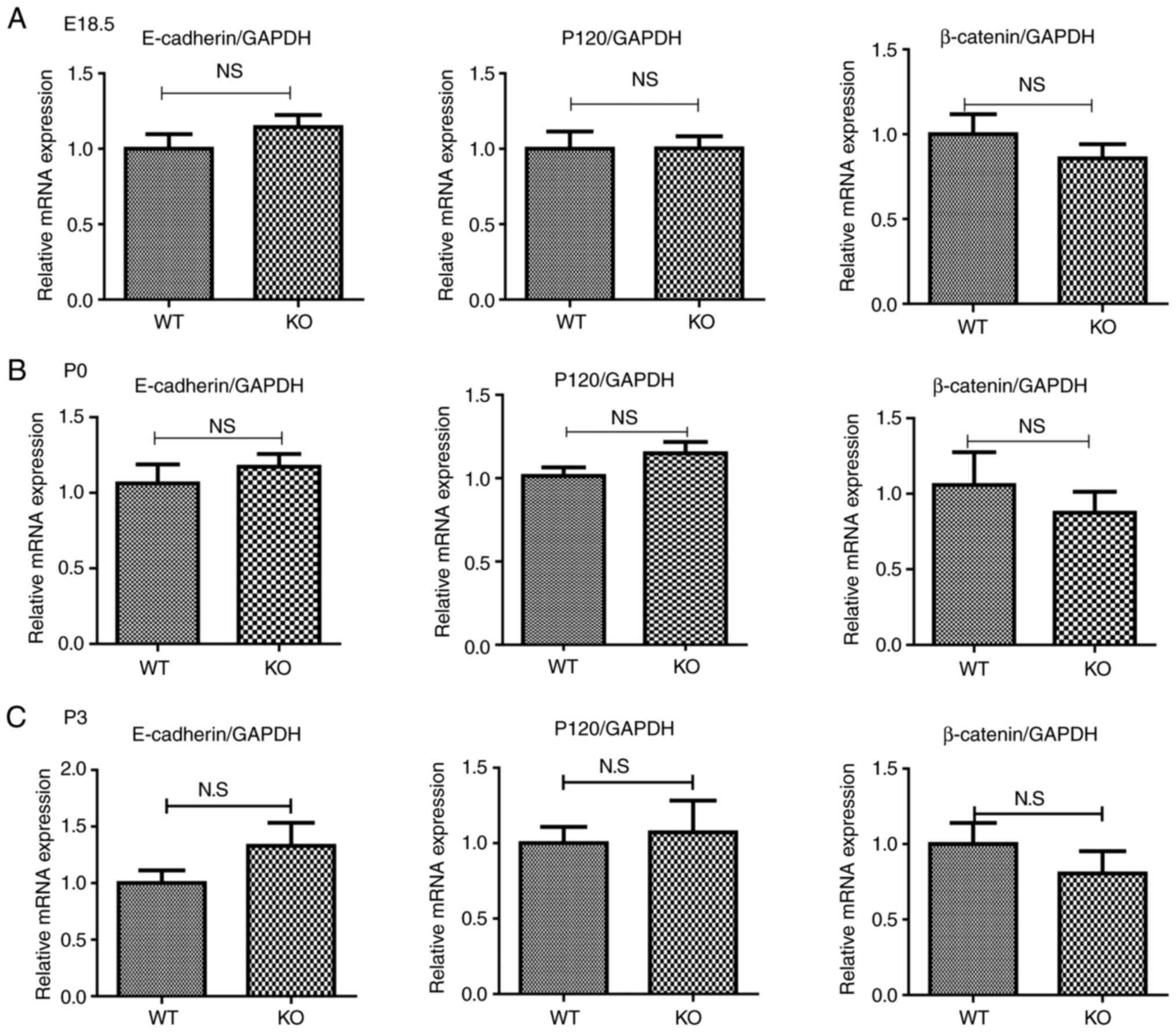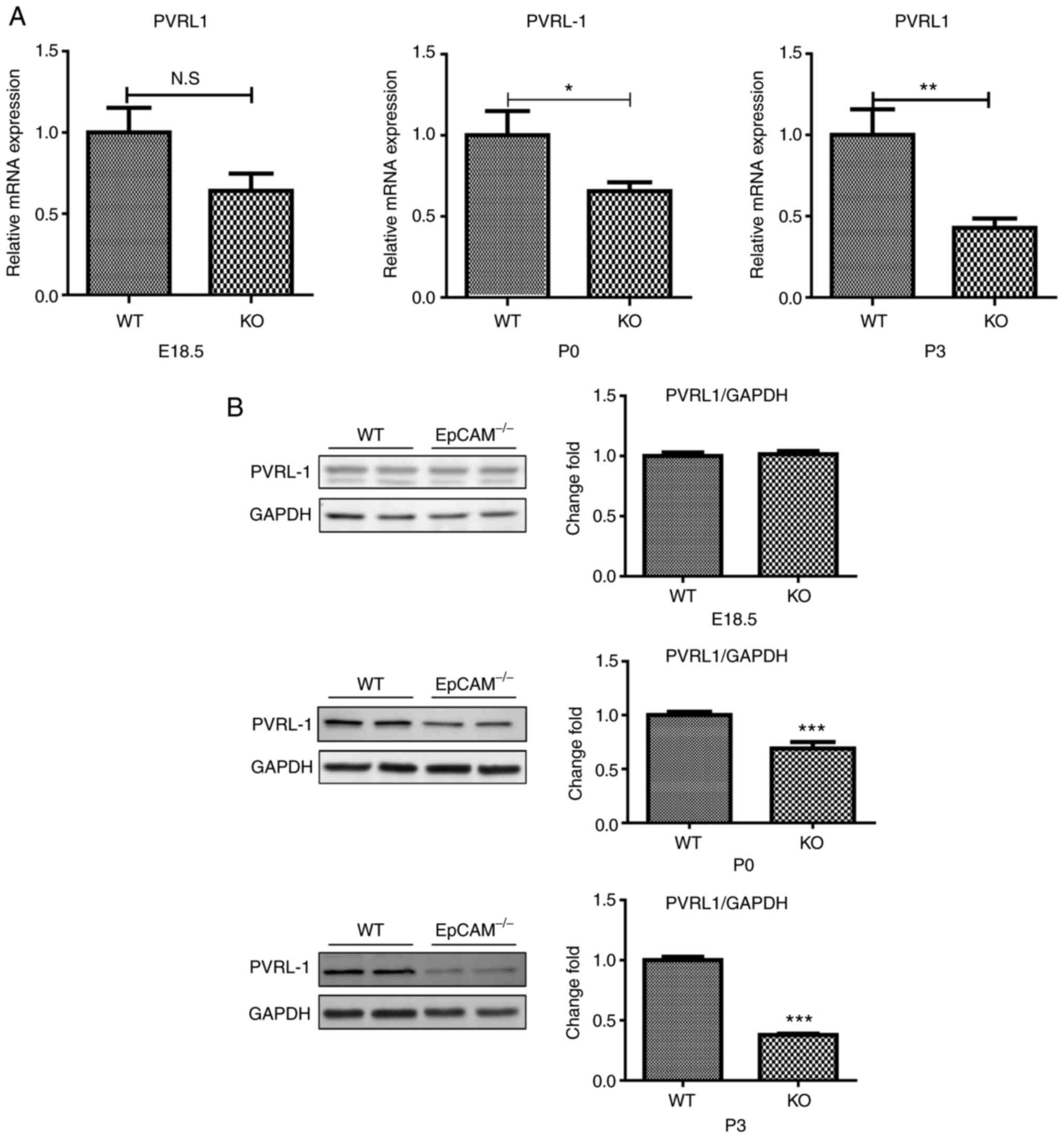|
1
|
Balzar M, Winter MJ, de Boer CJ and
Litvinov SV: The biology of the 17-1A antigen (Ep-CAM). J Mol Med
(Berl). 77:699–712. 1999. View Article : Google Scholar
|
|
2
|
Huang L, Yang Y, Yang F, Liu S, Zhu Z, Lei
Z and Guo J: Functions of EpCAM in physiological processes and
diseases (Review). Int J Mol Med. 42:1771–1785. 2018.PubMed/NCBI
|
|
3
|
Schnell U, Cirulli V and Giepmans BN:
EpCAM: Structure and function in health and disease. Biochim
Biophys Acta. 1828:1989–2001. 2013. View Article : Google Scholar : PubMed/NCBI
|
|
4
|
Slanchev K, Carney TJ, Stemmler MP,
Koschorz B, Amsterdam A, Schwarz H and Hammerschmidt M: The
epithelial cell adhesion molecule EpCAM is required for epithelial
morphogenesis and integrity during zebrafish epiboly and skin
development. PLoS Genet. 5:e10005632009. View Article : Google Scholar : PubMed/NCBI
|
|
5
|
Kamimoto K, Kaneko K, Kok CY, Okada H,
Miyajima A and Itoh T: Heterogeneity and stochastic growth
regulation of biliary epithelial cells dictate dynamic epithelial
tissue remodeling. Elife. 5:e150342016. View Article : Google Scholar : PubMed/NCBI
|
|
6
|
Schmelzer E, Zhang L, Bruce A, Wauthier E,
Ludlow J, Yao HL, Moss N, Melhem A, McClelland R, Turner W, et al:
Human hepatic stem cells from fetal and postnatal donors. J Exp
Med. 204:1973–1987. 2007. View Article : Google Scholar : PubMed/NCBI
|
|
7
|
Carneiro FP, Muniz-Junqueira MI, De
Vasconcelos Carneiro M, De Araújo Oliveira Í, Soares AC, De Vargas
Haar N, Takano GHS, De Sousa Vianna LM, De Carvalho Caldas G,
Vieira DLM, et al: Anti-EpCAM antibodies for detection of
metastatic carcinoma in effusions and peritoneal wash. Oncol Lett.
18:2019–2024. 2019.PubMed/NCBI
|
|
8
|
Sivagnanam M, Mueller JL, Lee H, Chen Z,
Nelson SF, Turner D, Zlotkin SH, Pencharz PB, Ngan BY, Libiger O,
et al: Identification of EpCAM as the gene for congenital tufting
enteropathy. Gastroenterology. 135:429–437. 2008. View Article : Google Scholar : PubMed/NCBI
|
|
9
|
Guerra E, Lattanzio R, La Sorda R, Dini F,
Tiboni GM, Piantelli M and Alberti S: mTrop1/Epcam knockout mice
develop congenital tufting enteropathy through dysregulation of
intestinal E-cadherin/β-catenin. PLoS One. 7:e493022012. View Article : Google Scholar
|
|
10
|
Lei Z, Maeda T, Tamura A, Nakamura T,
Yamazaki Y, Shiratori H, Yashiro K, Tsukita S and Hamada H: EpCAM
contributes to formation of functional tight junction in the
intestinal epithelium by recruiting claudin proteins. Dev Biol.
371:136–145. 2012. View Article : Google Scholar : PubMed/NCBI
|
|
11
|
Mueller JL, McGeough MD, Peña CA and
Sivagnanam M: Functional consequences of EpCam mutation in mice and
men. Am J Physiol Gastrointest Liver Physiol. 306:G278–G288. 2014.
View Article : Google Scholar :
|
|
12
|
Ng V, Ang S, Chan J and Choo A:
Characterization of epithelial cell adhesion molecule as a surface
marker on undifferentiated human embryonic stem cells. Stem Cells.
28:29–35. 2010. View Article : Google Scholar
|
|
13
|
Gerlach J, Foka H, Thompson R, Gridelli B
and Schmelzer E: Epithelial cell adhesion molecule fragments and
signaling in primary human liver cells. J Cell Physiol.
233:4841–4851. 2018. View Article : Google Scholar
|
|
14
|
Nagao K, Zhu J, Heneghan M, Hanson J,
Morasso M, Tessarollo L, Mackem S and Udey MC: Abnormal placental
development and early embryonic lethality in EpCAM-null mice. PLoS
One. 4:e85432009. View Article : Google Scholar :
|
|
15
|
Das S, Yu S, Sakamori R, Vedula P, Feng Q,
Flores J, Hoffman A, Fu J, Stypulkowski E, Rodriguez A, et al:
Rab8a vesicles regulate Wnt ligand delivery and Paneth cell
maturation at the intestinal stem cell niche. Development.
142:2147–2162. 2015. View Article : Google Scholar : PubMed/NCBI
|
|
16
|
Wu CJ, Mannan P, Lu M and Udey MC:
Epithelial cell adhesion molecule (EpCAM) regulates claudin
dynamics and tight junctions. J Biol Chem. 288:12253–12268. 2013.
View Article : Google Scholar : PubMed/NCBI
|
|
17
|
Litvinov SV, Balzar M, Winter MJ, Bakker
HA, Briaire-de Bruijn IH, Prins F, Fleuren GJ and Warnaar SO:
Epithelial cell adhesion molecule (Ep-CAM) modulates cell-cell
interactions mediated by classic cadherins. J Cell Biol.
139:1337–1348. 1997. View Article : Google Scholar
|
|
18
|
Winter MJ, Nagelkerken B, Mertens AE,
Rees-Bakker HA, Briaire-de Bruijn IH and Litvinov SV: Expression of
Ep-CAM shifts the state of cadherin-mediated adhesions from strong
to weak. Exp Cell Res. 285:50–58. 2003. View Article : Google Scholar : PubMed/NCBI
|
|
19
|
Maghzal N, Kayali HA, Rohani N, Kajava AV
and Fagotto F: EpCAM controls actomyosin contractility and cell
adhesion by direct inhibition of PKC. Dev Cell. 27:263–277. 2013.
View Article : Google Scholar : PubMed/NCBI
|
|
20
|
Salomon J, Gaston C, Magescas J,
Duvauchelle B, Canioni D, Sengmanivong L, Mayeux A, Michaux G,
Campeotto F, Lemale J, et al: Contractile forces at tricellular
contacts modulate epithelial organization and monolayer integrity.
Nat Commun. 8:139982017. View Article : Google Scholar : PubMed/NCBI
|
|
21
|
Patey N, Scoazec JY, Cuenod-Jabri B,
Canioni D, Kedinger M, Goulet O and Brousse N: Distribution of cell
adhesion molecules in infants with intestinal epithelial dysplasia
(tufting enter-opathy). Gastroenterology. 113:833–843. 1997.
View Article : Google Scholar : PubMed/NCBI
|
|
22
|
Yang Y, Liu S, Lei Z, Chen G, Huang L,
Yang F, Lei Y, Liu Y, Yang L, Liu W, et al: Circular RNA profile in
liver tissue of EpCAM knockout mice. Int J Mol Med. 44:1063–1077.
2019.PubMed/NCBI
|
|
23
|
Sato T, Fujita N, Yamada A, Ooshio T,
Okamoto R, Irie K and Takai Y: Regulation of the assembly and
adhesion activity of E-cadherin by nectin and afadin for the
formation of adherens junctions in Madin-Darby canine kidney cells.
J Biol Chem. 281:5288–5299. 2006. View Article : Google Scholar
|
|
24
|
Pathak SJ, Mueller JL, Okamoto K, Das B,
Hertecant J, Greenhalgh L, Cole T, Pinsk V, Yerushalmi B, Gurkan
OE, et al: EPCAM mutation update: Variants associated with
congenital tufting enteropathy and Lynch syndrome. Hum Mutat.
40:142–161. 2019. View Article : Google Scholar :
|
|
25
|
Sherman PM, Mitchell DJ and Cutz E:
Neonatal enteropathies: Defining the causes of protracted diarrhea
of infancy. J Pediatr Gastroenterol Nutr. 38:16–26. 2004.
View Article : Google Scholar
|
|
26
|
Schneider MR, Dahlhoff M, Horst D, Hirschi
B, Trülzsch K, Müller-Höcker J, Vogelmann R, Allgäuer M, Gerhard M,
Steininger S, et al: A key role for E-cadherin in intestinal
homeo-stasis and Paneth cell maturation. PLoS One. 5:e143252010.
View Article : Google Scholar
|
|
27
|
Bondow BJ, Faber ML, Wojta KJ, Walker EM
and Battle MA: E-cadherin is required for intestinal morphogenesis
in the mouse. Dev Biol. 371:1–12. 2012. View Article : Google Scholar : PubMed/NCBI
|
|
28
|
Gloushankova NA, Rubtsova SN and Zhitnyak
IY: Cadherin-mediated cell-cell interactions in normal and cancer
cells. Tissue Barriers. 5:e13569002017. View Article : Google Scholar : PubMed/NCBI
|
|
29
|
Hermiston ML and Gordon JI: Inflammatory
bowel disease and adenomas in mice expressing a dominant negative
N-cadherin. Science. 270:1203–1207. 1995. View Article : Google Scholar : PubMed/NCBI
|
|
30
|
Hermiston ML, Wong MH and Gordon JI:
Forced expression of E-cadherin in the mouse intestinal epithelium
slows cell migration and provides evidence for nonautonomous
regulation of cell fate in a self-renewing system. Genes Dev.
10:985–996. 1996. View Article : Google Scholar : PubMed/NCBI
|
|
31
|
Smalley-Freed WG, Efimov A, Short SP, Jia
P, Zhao Z, Washington MK, Robine S, Coffey RJ and Reynolds AB:
Adenoma formation following limited ablation of p120-catenin in the
mouse intestine. PLoS One. 6:e198802011. View Article : Google Scholar : PubMed/NCBI
|
|
32
|
Smalley-Freed WG, Efimov A, Burnett PE,
Short SP, Davis MA, Gumucio DL, Washington MK, Coffey RJ and
Reynolds AB: p120-catenin is essential for maintenance of barrier
function and intestinal homeostasis in mice. J Clin Invest.
120:1824–1835. 2010. View Article : Google Scholar : PubMed/NCBI
|
|
33
|
Short SP, Kondo J, Smalley-Freed WG,
Takeda H, Dohn MR, Powell AE, Carnahan RH, Washington MK, Tripathi
M, Payne DM, et al: p120-Catenin is an obligate haploinsufficient
tumor suppressor in intestinal neoplasia. J Clin Invest.
127:4462–4476. 2017. View Article : Google Scholar : PubMed/NCBI
|
|
34
|
Nusse R and Clevers H: Wnt/β-catenin
signaling, disease, and emerging therapeutic modalities. Cell.
169:985–999. 2017. View Article : Google Scholar : PubMed/NCBI
|
|
35
|
Chiacchiera F, Rossi A, Jammula S, Piunti
A, Scelfo A, Ordóñez-Morán P, Huelsken J, Koseki H and Pasini D:
Polycomb complex PRC1 preserves intestinal stem cell identity by
sustaining Wnt/β-catenin transcriptional activity. Cell Stem Cell.
18:91–103. 2016. View Article : Google Scholar
|
|
36
|
Ahmad R, Kumar B, Chen Z, Chen X, Müller
D, Lele SM, Washington MK, Batra SK, Dhawan P and Singh AB: Loss of
claudin-3 expression induces IL6/gp130/Stat3 signaling to promote
colon cancer malignancy by hyperactivating Wnt/β-catenin signaling.
Oncogene. 36:6592–6604. 2017. View Article : Google Scholar : PubMed/NCBI
|
|
37
|
Janeckova L, Fafilek B, Krausova M,
Horazna M, Vojtechova M, Alberich-Jorda M, Sloncova E, Galuskova K,
Sedlacek R, Anderova M and Korinek V: Wnt signaling inhibition
deprives small intestinal stem cells of clonogenic capacity.
Genesis. 54:101–114. 2016. View Article : Google Scholar : PubMed/NCBI
|
|
38
|
Sun X, Yao L, Liang H, Wang D, He Y, Wei
Y, Ye L, Wang K, Li L, Chen J, et al: Intestinal epithelial PKM2
serves as a safeguard against experimental colitis via activating
β-catenin signaling. Mucosal Immunol. 12:1280–1290. 2019.
View Article : Google Scholar : PubMed/NCBI
|
|
39
|
Kobielak A and Fuchs E: Alpha-catenin: At
the junction of inter-cellular adhesion and actin dynamics. Nat Rev
Mol Cell Biol. 5:614–625. 2004. View Article : Google Scholar : PubMed/NCBI
|
|
40
|
Shimono Y, Rikitake Y, Mandai K, Mori M
and Takai Y: Immunoglobulin superfamily receptors and adherens
junctions. Subcell Biochem. 60:137–170. 2012. View Article : Google Scholar : PubMed/NCBI
|
|
41
|
Takai Y, Ikeda W, Ogita H and Rikitake Y:
The immunoglobulin-like cell adhesion molecule nectin and its
associated protein afadin. Annu Rev Cell Dev Biol. 24:309–342.
2008. View Article : Google Scholar : PubMed/NCBI
|
|
42
|
Martinez-Rico C, Pincet F, Perez E, Thiery
JP, Shimizu K, Takai Y and Dufour S: Separation force measurements
reveal different types of modulation of E-cadherin-based adhesion
by nectin-1 and -3. J Biol Chem. 280:4753–4760. 2005. View Article : Google Scholar
|















